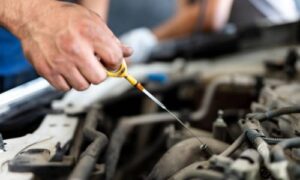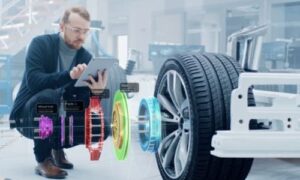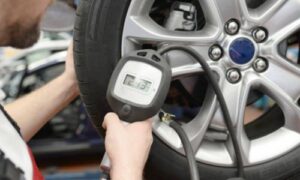What exactly causes tire blowouts, and how can you prevent them? Let’s explore the reasons behind tire meltdowns and ways to keep your tires rolling safely. Cruising down the road, music pumping, windows down – it’s a picture of driving bliss. But that bliss can vanish instantly with a loud bang and a car veering out of control. We’re talking about a tire blowout, a sudden tire failure that can be frightening and dangerous.
Underinflated Tires: The Silent Culprit
The leading cause of tire blowouts is a sneaky one – underinflation. Think of your tire as a balloon. An underinflated balloon is more prone to stretching and weakening. The same applies to tires. When a tire is underinflated, the sidewalls flex excessively as they roll, generating heat. This heat buildup weakens the tire’s internal structure, making it more susceptible to blowouts.
How to Avoid Underinflation:
- Check your tire pressure regularly: It’s recommended to check pressure at least once a month and before long trips. Remember, the recommended pressure is listed on a sticker in your driver’s door jamb or your owner’s manual.
- Don’t rely solely on the TPMS (Tire Pressure Monitoring System) warning light: While TPMS can be helpful, it only activates when pressure falls significantly below the recommended level. Regular checks ensure you catch minor underinflation before it becomes a major problem.
Overloading Your Vehicle: Pushing the Limits
Every vehicle has a weight limit, and exceeding that limit puts undue stress on your tires. Imagine carrying a backpack twice your weight—not comfortable, right? The same goes for your car. An overloaded vehicle forces the tires to work extra hard, leading to heat buildup and an increased risk of blowouts.
How to Avoid Overloading:
- Please consult your owner’s manual. It specifies your car’s weight limit, including passengers and cargo.
- Distribute weight evenly: Don’t overload one side of the vehicle.
Uneven Tread Wear: A Sign of Trouble
The grooves on your tire tread are there for a reason – they channel water away and provide grip on the road. When your tire tread wears unevenly, these grooves become compromised. Bald spots or uneven wear can lead to blowouts, especially when encountering potholes or bumps.
How to Avoid Uneven Tread Wear:
- Tire rotations: Regularly rotating your tires (usually every 5,000-7,000 miles) ensures even wear across all treads.
- Wheel alignment: Improper wheel alignment can cause uneven tread wear. Check your alignment periodically, especially after hitting a curb or experiencing front-end damage.
Damaged Tires: Ticks and Time Bombs
Tires are not invincible. Road hazards like potholes, curbs, and debris can damage them. If left unaddressed, these damages can develop into weak spots or bulges, increasing the risk of blowouts. Even seemingly minor sidewall injuries shouldn’t be ignored.
How to Avoid Damaged Tires:
- Practice defensive driving: Maintain a safe distance from the car ahead of you to avoid sudden stops that might necessitate hard swerving, potentially damaging your tires.
- Inspect your tires regularly: Look for cuts, punctures, bulges, or any signs of damage on the sidewalls and tread.
- Replace damaged tires promptly: Don’t gamble with your safety. If you see damage, get the tire inspected by a professional and replace it if necessary.
Aging Tires: Causes of Tire Blowouts
Just like anything else, tires age. Over time, the rubber compounds in the tire can deteriorate, making them more susceptible to blowouts. While tread depth is often a good indicator of tire life, other factors must be considered. Check your owner’s manual for recommendations on replacing tires based on age, even if they have sufficient tread depth.
Manufacturer Defects: Causes of Tire Blowouts
In rare instances, tire blowouts can be caused by manufacturing defects. These defects might not be readily apparent and can develop into failures over time.
How to Mitigate Manufacturer Defects:
- Buy tires from reputable brands: Look for brands known for their quality and safety standards.
- Register your tires: Many tire manufacturers offer warranty programs. Registering your tires ensures you’ll be notified of any safety recalls related to your specific tires.
Safe travels: What to Do in Case of a Blowout
Even with the best precautions, blowouts can sometimes happen. Here’s what to do if you experience one:
- Maintain control: Don’t slam on the brakes! Take your foot off the gas pedal and hold the steering wheel firmly to maintain as much control as possible. The car will naturally veer towards the side of the blowout.
- Brake gradually: Once your speed has decreased, slowly apply the brakes to bring the car to a complete stop. Avoid using the emergency brake, which can lock the wheels and make steering difficult.
- Turn on your hazard lights: Alert other drivers behind you that you’re experiencing trouble.
- Pull over to a safe location: Once you’ve come to a complete stop, steer the car to a secure location away from traffic, preferably onto the shoulder of the road.
After the Blowout:
- Assess the situation: Once you’ve ensured your safety and the safety of others, check for any injuries. If there are any, call for emergency assistance immediately.
- Change the tire: If you’re comfortable doing so and have a spare tire and jack, you can change the flat tire yourself. However, if you’re unsure or feel unsafe, call for roadside assistance.
- Inspect your tire: Don’t replace the flat tire; keep driving. Have a qualified mechanic inspect the blown-out tire to determine the cause of the failure. This can help prevent future blowouts.
Statistics about Causes of Tire Blowouts
- Blowout prevalence: The National Highway Traffic Safety Administration (NHTSA) estimates approximately 11,000 tire-related crashes annually in the US. (Source: NHTSA)
- Underinflation impact: Studies by the Rubber Manufacturers Association (RMA) suggest that underinflated tires can contribute to decreased fuel efficiency and increased tire wear.
Conclusion of Causes of Tire Blowouts
Tire blowouts can be scary and dangerous, but understanding the causes and taking preventive measures can significantly reduce your risk of experiencing one. Remember, your tires are the only point of contact your car has with the road, so treating them with care is paramount for safety. Make regular pressure checks, avoid overloading, rotate your tires, and inspect them for damage—these simple steps can make a big difference.
FAQs about Causes of Tire Blowouts
1. What’s the most common cause of tire blowouts?
Underinflation is the leading culprit. An underinflated tire flexes excessively, generating heat that weakens the internal structure and increases blowout risk.
2. How often should I check my tire pressure?
It’s recommended to check tire pressure at least once a month and before long trips. Always check pressure when the tires are cold (not driven for at least a few hours).
3. What should I do if I experience a blowout?
Maintain control, gradually brake, turn on hazard lights, pull over to a safe location, and assess the situation. If you’re comfortable, change the tire. Otherwise, call for roadside assistance.
4. Can I drive on a spare tire?
Spare tires are typically designed for temporary use. Check your owner’s manual for speed and distance limitations when using a spare tire.
At Phoenix Windshield Repairs, we want you to see the road clearly and travel safely. By prioritizing tire safety and keeping these tips in mind, you can minimize the risk of blowouts and ensure a smooth journey. For any windshield concerns, don’t hesitate to contact us—we’re here to help!






